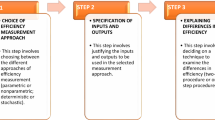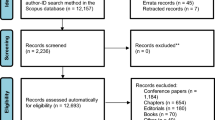Abstract
Despite the increasing recognition of the importance of the research mission of universities, no previous work has investigated the research productivity and research strategies of Asia Pacific business schools. This article fills this important gap by conducting the first study to rank the publication productivity of 130 Asia Pacific business schools. Drawing on data from the UTD Top 100 Business School Research Rankings™ and several additional sources, we rank Asia Pacific business schools’ research productivity in three areas: (1) twenty-four leading business journals, (2) seven top management journals, and (3) five Asia Pacific management journals. We also extend this analysis by documenting the distinct publishing strategies of various Asia Pacific business schools—global, local, or both.

Similar content being viewed by others
Notes
For example, of the 4,387 postsecondary educational institutions in the United States recognized by the Carnegie Foundation in 2002, only 163 (3.71%) had PhD-granting status in the full range of disciplines and only 89 (2.03%) were ranked in the highest category of “Research I.”
The database is interactive and continuously updated as new research is published. See Appendix 1.
Publications in Manufacturing & Service Operations and Management are tracked starting in 1999, when it published its first volume.
Although Hofstede (2007) would probably consider Israel and Turkey as “Asian,” schools in Israel have been considered in rankings of research productivity among European schools (Baden-Fuller et al., 2000) and schools in Turkey have not been active in publishing in these 24 journals. Therefore, we have excluded schools in Israel and Turkey.
In the Asia Pacific Journal of Management during the period 1997-2006, the top ten institutional contributors were (1) NUS, (2) CUHK, (3) Lingnan University, Hong Kong, (4) City University of Hong Kong, (5) Nanyang Technological University, Singapore, (6) Hong Kong Baptist University, (7) HKUST, (8 tied) Concordia University, Canada, (8 tied) Xi’an Jiaotong University, China, (10 tied) Ohio State University, USA, and (10 tied) Thunderbird, USA (Pleggenkuhle-Miles et al., 2007: 475).
We suspect that the reward system in Australia may play a role. Australia’s Department of Education, Science, and Training (DEST) point system rewards quantity regardless of the outlets (Harzing, 2005; Yang & Terjesen, 2007: 503). This may explain the significant interest among Australian authors in Asia Pacific outlets.
In some disciplines, Asia Pacific business schools now rank very high. In international business, five Asia Pacific business schools are now in the global top 20, led by CUHK (sixth in the world—see Xu et al., 2008).
References
Agrawal, A., & Cockburn, I. 2003. The anchor tenant hypothesis: Exploring the role of large, local, R&D-intensive firms in regional innovation systems. International Journal of Industrial Organization, 21: 1227–1253.
Armstrong, J. S. 1995. The Devil’s advocate responds to an MBA student’s claim that research harms learning. Journal of Marketing, 59: 101–106.
Au, K. 2007. Self-confidence does not come isolated from the environment. Asia Pacific Journal of Management, 24: 491–496.
Baden-Fuller, C., Ravazzolo, F., & Schweizer, T. 2000. Making and measuring reputations: The research rankings of European business schools. Long Range Planning, 33: 621–650.
Brouthers, K. D., Mudambi, R., & Reeb, D. M. 2005. The homerun hypothesis: Influencing the boundaries of knowledge. Working paper available at SSRN: http://ssrn.com/abstract=1015588.
Carlsson, B., & Mudambi, R. 2003. Globalization, entrepreneurship and public policy: A systems view. Industry and Innovation, 10: 103–116.
Chan, K. C., Fung, H. G., & Lai, P. 2005. Membership of the editorial boards and rankings of schools with international business orientation. Journal of International Business Studies, 36: 452–469.
Chan, K. C., Chen, C. R., & Cheng, L. T. W. 2006. A ranking of accounting research output in the European region. Accounting and Business Research, 36: 3–17.
Ehrenberg, R. 2005. Going broke by degree: A review essay. Journal of Labor Research, 26: 739–752.
Gioia, D. A., & Corley, K. G. 2002. Being good versus looking good: Business school rankings and the Circean transformation from substance to image. Academy of Management Learning & Education, 1: 107–120.
Harzing, A. 2005. Australian research output in economics and business: High volume, low impact? Australian Journal of Management, 30: 183–200.
Hofstede, G. 2007. Asian management in the 21st century. Asia Pacific Journal of Management, 24: 411–420.
Kumar, V., & Kundu, S. K. 2004. Ranking the international business schools: Faculty publications as the measure. Management International Review, 44: 213–228.
Lau, C. M. 2007. The first decade of the Asia Academy of Management. Asia Pacific Journal of Management, 24: 401–410.
Leung, K. 2007. The glory and tyranny of citation impact: An East Asian perspective. Academy of Management Journal, 50: 510–513.
Li, Y., & Peng, M. W. 2008. Developing theory from strategic management research in China. Asia Pacific Journal of Management, 25 (in press).
Meyer, K. E. 2006. Asian management research needs more self-confidence. Asia Pacific Journal of Management, 23: 119–137.
Meyer, K. E. 2007. Asian contexts and the search for general theory in management research: A rejoinder. Asia Pacific Journal of Management, 24: 527–534.
Meyer, K. E., & Peng, M. W. 2005. Probing theoretically into Central and Eastern Europe: Transactions, resources, and institutions. Journal of International Business Studies, 35: 600–621.
Mudambi, R., & Navarra, P. 2004. Is knowledge power? Knowledge flows, subsidiary power and rent-seeking within MNCs. Journal of International Business Studies, 35: 385–406.
Peng, M. W. 2005. From China strategy to global strategy. Asia Pacific Journal of Management, 22: 123–141.
Peng, M. W. 2007. Celebrating 25 years of Asia Pacific management research. Asia Pacific Journal of Management, 24: 385–393.
Peng, M. W., & Zhou, J. Q. 2006. Most cited articles and authors in global strategy research. Journal of International Management, 12: 490–508.
Pleggenkuhle-Miles, E. G., Aroul, R. R., Sun, S. L., & Su, Y. S. 2007. The adolescence of Asia management research: APJM, 1997–2006. Asia Pacific Journal of Management, 24: 467–489.
Pocklington, T., & Tupper, A. 2002. No place to learn: Why universities aren’t working. Vancouver: University of British Columbia Press.
Pomfret, R., & Wang, C. W. 2003. Evaluating the research output of Australian universities’ economics departments. Australian Economic Papers, 42: 418–441.
Quer, D., Claver, E., & Rienda, L. 2007. Business and management in China: A review of empirical research in leading international journals. Asia Pacific Journal of Management, 24: 359–384.
Ramaswamy, K. 2007. Asian management research needs broader initiatives and focused incentives. Asia Pacific Journal of Management, 24: 519–525.
Robinson, P. 1994. Snapshots from hell. New York: Warner Books.
Schmotter, J. W. 2001. Making sense of the rankings. Selections, 1: 2.
Schramm, C. J. 2006. The broken MBA. Chronicle of Higher Education, 52: B16.
Siemens, J., Burton, S., Jensen, T., & Mendoza, N. 2005. An examination of the relationship between research productivity in prestigious business journals and popular press business school rankings. Journal of Business Research, 58: 467–476.
Tracy, J., & Waldfogel, J. 1997. The best business schools: A market-based approach. Journal of Business, 70: 1–31.
Trieschmann, J. S., Dennis, A. R., Northcraft, G. B., & Niemi Jr., A. W. 2000. Serving multiple constituencies in business schools: M.B.A. program versus research performance. Academy of Management Journal, 43: 1130–1141.
Xu, S., Yalcinkaya, G., & Seggie, S. 2008. Prolific authors and institutions in leading international business journals. Asia Pacific Journal of Management, 25 (in press).
Yang, X., & Terjesen, S. 2007. In search of confidence: Context, collaboration, and constraints. Asia Pacific Journal of Management, 24: 497–507.
Author information
Authors and Affiliations
Corresponding author
Additional information
This research was supported, in part, by the Perelman Senior Research Fellowship at Temple, the Provost’s Distinguished Professorship at UTD, and the National Science Foundation (CAREER SES 0552089). We thank Andrew Delios for helping us collect data and for his hands-on editorial assistance. We also thank Dave Ahlstrom and Anne-Wil Harzing for helpful comments and Ted Khoury, Kenny Oh, and Sylvia Yen for research assistance. We are grateful to Dean Hasan Pirkul for granting us permission to use data from the UTD Top 100 Business School Research Rankings™. All views expressed are ours and not those of the underwriters.
Appendices
Appendix 1
The Database for the UTD Top 100 Business School Research Rankings™
The UTD Top 100 Business School Research Rankings™ (http://top100.utdallas.edu) is a database that reports publications in 24 leading business journals (see Table 1). It covers the period between 1990 and the present, and is being updated on a continuing basis as new research is published. It produces two rankings—North America and worldwide.
Single-authored paper is counted as one publication for a university, and research contributed by more than one author is weighted by the number of authors in the paper. As such, the rankings can reflect universities’ academic output in an accurate, objective manner. These rankings are not adjusted for faculty size, due to the difficulties in accurately measuring faculty size.
The database is highly interactive and flexible. It not only allows users to get the list of particular journals (such as operations management journals), but also enables researchers to sort out the publication of a university, a scholar, or a particular title (“SEARCH” by school name, author name, and article title, respectively). To get the first top 100 rankings listed in Appendix 2 (1990),
-
1.
Go to “Rankings by journal,” and select “check all journals” (any single journal or any combination of the 24 journals can also be selected)
-
2.
Select time “from 1990” and “to 1990” (it is possible to select any year or any combination of certain years since 1990)
-
3.
Click “worldwide” (the other alternative is “North America”)
Appendix 2
UTD Top 100 Business School Research Worldwide Rankings™
Rights and permissions
About this article
Cite this article
Mudambi, R., Peng, M.W. & Weng, D.H. Research rankings of Asia Pacific business schools: Global versus local knowledge strategies. Asia Pacific J Manage 25, 171–188 (2008). https://doi.org/10.1007/s10490-008-9086-3
Published:
Issue Date:
DOI: https://doi.org/10.1007/s10490-008-9086-3




